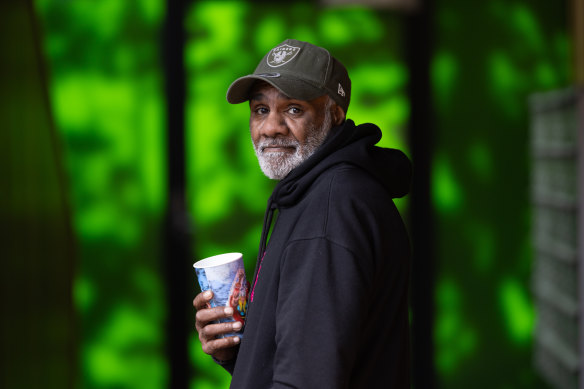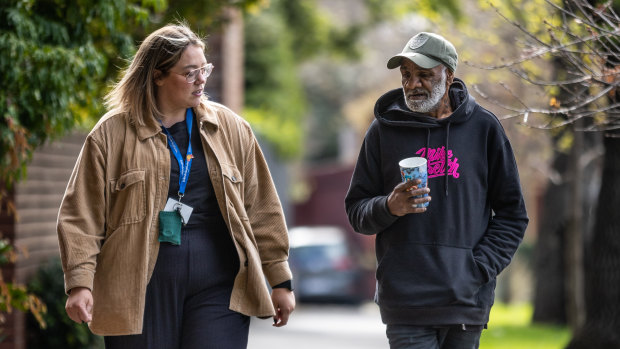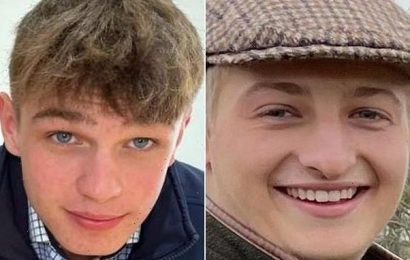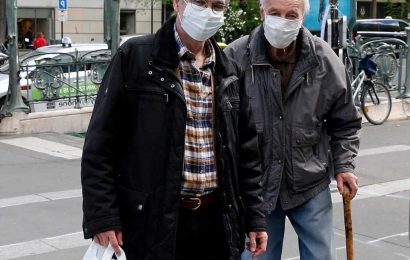Paul’s pathway off the streets and into a home started with something simple but powerful: his name was added to a list.
The 48-year-old was sleeping outside a 7-Eleven three years ago when he was approached by out-reach workers from Port Phillip Zero — a pilot aimed at ending street homelessness — and added to a register of rough sleepers in the municipality, called the By-Name List.
“I’ve more or less been homeless since I was 12 and I left my foster parents,” Paul says.
Paul, a former rough sleeper who was housed after being added to the By-Name List.Credit:Jason South
But once Paul was added to the By-Name List, a multi-agency team — including the council, St Kilda police, housing providers, health services and Indigenous organisations — worked together to find him housing and support.
“People aren’t in the shadows anymore once they’re on the By-Name List,” says George Hatvani, a manager at Launch Housing, one of Victoria’s largest homelessness services providers.
“What we’re doing is saying ‘OK, what is the pathway out of homelessness for this person’?”
After years of sleeping rough, Paul moved into his own home in St Kilda five months ago. “Just going home is the best part. Just hearing the keys rattle in my pocket and thinking ‘yeah, I’ve got a home to go to now’.”
Port Phillip Zero is part of the Advance to Zero movement, a hyper-local approach that aims to end homelessness one community at a time, starting with rough sleeping.
It’s derived from the Built for Zero initiative in the US. One hundred cities are working to achieve a standard known as functional zero, where the number of people being housed each month is greater on average than those either currently or newly homeless.
“There is this myth that homelessness is unsolvable, but we know how to end homelessness on Melbourne’s streets,” Hatvani says.
Progress has been made in the City of Port Phillip, which for years has been a homelessness hotspot. The number of rough sleepers has dropped by 30 per cent; from a peak of 94 in September 2019 to 29 in July this year.
“It’s an early-stage result, but it’s still very, very encouraging, and it’s better than most other results that we’ve had in our programs over the past 20 years or so,” says Mayor Marcus Pearl.
Council to Homeless Persons CEO Jenny Smith said while functional zero was important, the scheme focused on rough sleepers, who make up only about 5 per cent of the wider homeless population.
“People can get very excited that they are dealing with homelessness, but it’s only a small group,” she said. “You’re focused on a very visible vulnerable group, you’ve got to be careful to look out for young people, vulnerable women and children as well — people who haven’t been homeless for a long time.”
People remain on the By-Name List while they are rough sleeping or in crisis or transitional accommodation.
They are only taken off the list if they have obtained secure long-term housing, moved out of the area or services have not been able to contact them for more than 90 days.
But there are also critics of functional zero.
Guy Johnson, a professor of homelessness at RMIT, said it was misleading to suggest someone was no longer homeless if they had moved out of the area or were uncontactable.
“Most likely, they’re still homeless,” Johnson says. “Any conclusions that you draw from that data are going to be flawed. If a community does achieve functional zero, it may well be interpreted by some that they’ve actually ended homelessness. And this is likely to be far from the case.”
When St Kilda’s Gatwick Hotel closed in 2017, services in the City of Port Phillip worked together to rehouse those who had been living in the notorious rooming house.
They built on this collaboration when the Port Phillip Zero pilot began that year, meeting every week to find tailored housing and support for each individual on the By-Name List. Indigenous people and those aged over 50 are prioritised.
“The advantage that we have now is that information is instant,” says Nicola Miles, the By-Name List worker for the City of Port Phillip.
“We’re all sitting in front of our computers with our clients’ details in front of us, and we can quickly share information about whether we’ve seen them, whether they’ve been accessing services.”
Key to Port Phillip Zero’s success has been 15 services working together rather than operating separately. But there is still the challenge of a lack of social housing, with 55,000 households on the waiting list.
In July 2020, the Victorian government announced the From Homelessness to a Hotel program, providing $167 million to house and support people who were put up in hotels during lockdowns.
Importantly, through this measure, people sleeping rough were moved to a higher priority position on the social housing waitlist.
“Housing has become a little bit more available since the peak of the pandemic,” says Hatvani, the Functional Zero Manager at Launch Housing.
“Our job was really to get as many people into it as possible from the By-Name List.”
This meant Paul could finally be moved into housing and has a support worker provided by Wintringham.
Paul with his support worker from Wintringham, Lauren Finnegan.Credit:Jason South
Adelaide and Brisbane are both working towards functional zero. In Victoria, Advance to Zero projects are also being rolled out in Dandenong, Stonnington and Frankston local government areas. A further three councils are considering them.
“Local government is a huge champion of this in Victoria, philanthropy has backed this, the sector have backed it,” says David Pearson, the CEO of the Australian Alliance to End Homelessness, an independent organisation that supports local communities to end homelessness.
“But whilst the Victorian government led the way in responding to COVID, it is one of the few governments that has never invested in Advance to Zero methodology directly.”
The government says it funds Launch Housing to manage assertive outreach teams, which assist Functional Zero approaches in Frankston and Dandenong and a supportive housing team in Dandenong.
In addition, the Private Rental Assistance Program Plus program provides tailored and targeted outreach support to assist people to attain and retain private rental housing.
“The Andrews Labor government is supporting innovative solutions and partnerships that seek to end rough sleeping in our local communities,” a spokesperson says.
Paul’s support worker, Lauren Finnegan, visits him twice a week, and takes him shopping and to appointments. “I’ve never had that before, I find it helpful,” he says. “Some days I just can’t be bothered, but if I have an appointment Lauren will ring and make sure I am ready for it.”
Paul is happy to have a roof over his head.
“I am getting old and being out on the streets was not helping much with my age and my health,” he says. “I can’t complain. At least I can go home every night.”
The Morning Edition newsletter is our guide to the day’s most important and interesting stories, analysis and insights. Sign up here.
Most Viewed in National
From our partners
Source: Read Full Article








